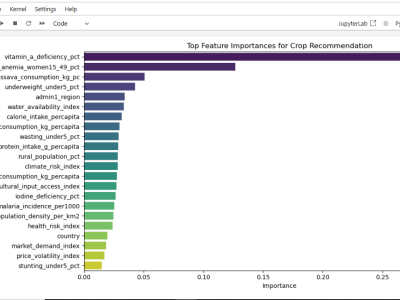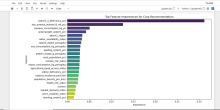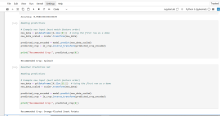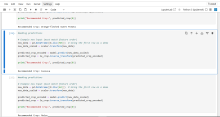Health-Aware, Multi-Model AI System for Predictive Agricultural Yield Planning

- Citation Author(s):
- Submitted by:
- DANIEL MAKALA
- Last updated:
- Links:
Abstract
- Overview
With the goal of merging steady health and nutrition with sustainable agricultural practices, I’ve developed a multi-model AI-powered recommendation system tailored to the African context. This system is designed to support health-based farming, with a special focus on improving yield prediction and maintaining a consistent nutritional value chain across changing seasons.
A key challenge in many regions is the overreliance on specific crops that only thrive in one climatic season. This project seeks to address that by using AI to recommend optimal planting decisions across different seasons—suggesting both what to grow and what can be used as a nutritional or market-value substitute when climate conditions aren’t favorable.
At its core, the system leverages a robust dataset and multiple AI models to:
Recommend the best crops to plant per season, based on regional and climatic data.
Suggest substitutes for key crops during off-seasons or climate shifts.
Highlight nutritionally equivalent or superior crops to maintain dietary health.
Provide health-aware and region-specific crop recommendations.
Align crop suggestions with market demand forecasts, helping farmers maximize profit.
- Methodology
The foundation of this project is data gathered through extensive research on food production patterns across African countries. The process began with identifying each country's main staple foods and analyzing their environmental suitability, particularly focusing on crops that are widely cultivated due to their adaptability to local climate and soil conditions.
For each country, I examined:
The primary staple crop(s) most commonly grown.
Alternative crops with similar growing conditions that could serve as seasonal or nutritional substitutes.
The agro-ecological zones and at least one major production region or city, to ground the data in localized farming realities.
In addition to agricultural data, the methodology incorporated:
Health statistics and national nutritional needs, to align crop recommendations with public health goals.
Insights into health trends, such as rising nutrition-related diseases or deficiencies.
Market insights, including demand patterns and price stability for various crops.To ensure credibility and relevance, I also incorporated findings from sample collections and reports from agricultural research centers, including data from organizations like the Food and Agriculture Organization (FAO) and regional research bodies focused on sustainable farming in Africa.
- Data features
My dataset has the 120 records with the data format as shown below
Data columns (total 24 columns):
0 country - object
1 admin1_region - object
2 year - int64
3 vitamin_a_deficiency_pct - float64
4 iron_anemia_women15_49_pct - float64
5 iodine_deficiency_pct - float64
6 stunting_under5_pct - float64
7 wasting_under5_pct - float64
8 underweight_under5_pct - float64
9 malaria_incidence_per1000 - float64
10 calorie_intake_percapita - int64
11 protein_intake_g_percapita - int64
12 maize_consumption_kg_percapita - float64
13 rice_consumption_kg_percapita - float64
14 cassava_consumption_kg_pc - float64
15 price_volatility_index - float64
16 health_risk_index - float64
17 population_density_per_km2 - float64
18 rural_population_pct - float64
19 market_demand_index - float64
20 recommended_crop - object
21 climate_risk_index - float64
22 water_availability_index - float64
23 agricultural_input_access_index - float64
dtypes: float64(18), int64(3), object(3)
| Feature | Description | Purpose in the Model |
|---|---|---|
| country | Name of the country (e.g., Nigeria, Kenya, Ethiopia) | Regionalizes recommendations to national food systems and policies |
| admin1_region | First administrative level (state/province) | Adds local context, allowing for more granular crop targeting |
| year | Data collection year | Supports time-series analysis and trend detection |
| vitamin_a_deficiency_pct | % of population deficient in Vitamin A | Guides recommendation of Vitamin A-rich crops (e.g., orange-fleshed sweet potatoes) |
| iron_anemia_women15_49_pct | % of women aged 15–49 with iron-deficiency anemia | Supports promotion of iron-rich crops (e.g., beans, lentils) |
| iodine_deficiency_pct | % of population with iodine deficiency | Informs the inclusion of iodine-rich food sources (e.g., seaweed, iodized produce) |
| stunting_under5_pct | % of children under 5 experiencing stunting | Nutritional baseline; tied to long-term food access and diversity |
| wasting_under5_pct | % of under-5 children with wasting | Tracks acute malnutrition trends |
| underweight_under5_pct | Underweight prevalence in children under 5 | General public health and nutrition marker |
| malaria_incidence_per1000 | Malaria cases per 1000 population | Affects farm labor availability and seasonal planning |
| calorie_intake_percapita | Average daily kilocalorie intake per person | Helps identify regions needing energy-dense staples |
| protein_intake_g_percapita | Average daily protein intake per person | Influences promotion of high-protein crops (e.g., legumes, soybeans) |
| maize_consumption_kg_percapita | Annual maize consumption per capita | Indicates maize dependency and market saturation |
| rice_consumption_kg_percapita | Annual rice consumption per capita | Guides rice availability and alternative recommendations |
| cassava_consumption_kg_pc | Annual cassava consumption | Reflects its role in food security and substitute viability |
| price_volatility_index | Index measuring fluctuations in food prices | Captures economic vulnerability and resilience of crop markets |
| health_risk_index | Composite index of population health risks | Allows health-aware weighting in recommendation logic |
| population_density_per_km2 | Population per square kilometer | Higher density may point to urban farming opportunities |
| rural_population_pct | Percentage of population in rural areas | Suggests farming methods: manual vs mechanized |
| market_demand_index | Composite index (0–1) of market demand | Predicts economic viability and profitability of crops |
Industry specific Applications Of my Project
This AI-powered recommendation system offers practical solutions across several sectors, especially in areas that align with the UN Sustainable Development Goals (SDGs). Below are five core use cases:
1. Smart Crop Planning for Food Security
Aligned SDG: SDG 2 – Zero Hunger
Use Case:
Governments or NGOs can use the system to recommend crops based on regional nutrition deficiencies and seasonal patterns, ensuring year-round food availability in both rural and urban areas.
Example:
In drought-prone regions of Kenya, the system may suggest substituting maize with drought-resistant and iron-rich sorghum during dry seasons.
Advantages:
Reduces seasonal hunger gaps
Promotes local crop diversity
Strengthens resilience to climate shocks
2. Health-Aware Nutrition Programs
Aligned SDG: SDG 3 – Good Health and Well-Being
Use Case:
Public health departments can integrate this model into national feeding programs to improve nutritional outcomes, especially for vulnerable groups like children and women.
Example:
In West Africa, where Vitamin A deficiency is high, the model can help identify and promote planting of bio fortified sweet potatoes in local gardens.
Advantages:
Tackles micronutrient deficiencies
Supports maternal and child health
Links agriculture directly to healthcare outcomes
3. Market-Aligned Farming Decisions
Aligned SDG: SDG 8 – Decent Work and Economic Growth
Use Case:
Farmers' cooperatives and agribusinesses can use demand forecasts and market volatility data to choose high-value crops, optimizing income while minimizing losses.
Example:
In Ghana, a farmer might receive a recommendation to plant sesame instead of maize due to rising sesame demand and lower maize market prices.
Advantages:
Increases farmer profitability
Reduces overproduction and post-harvest losses
Encourages market-driven agriculture
4. Climate-Smart Agricultural Planning
Aligned SDG: SDG 13 – Climate Action
Use Case:
Agricultural planners and climate agencies can use the system to model crop resilience and adaptability under different weather conditions, helping shape climate policies.
Example:
In Southern Africa, the system can flag areas vulnerable to future rainfall decline and suggest alternative crops like millet or cowpea for better resilience.
Advantages:
Promotes adaptive farming
Mitigates risks from climate variability
Supports environmental sustainability
- Tech-Driven Innovation in Agriculture
Aligned SDG: SDG 9 – Industry, Innovation, and Infrastructure
Use Case:
The system serves as a technological bridge for modernizing agriculture in Africa by introducing data-driven decision-making, AI-powered insights, and precision recommendations to smallholder farmers, startups, and agritech hubs.
Example:
A local agri-tech startup in Rwanda could integrate the model into a mobile app, enabling rural farmers to receive real-time, AI-based crop recommendations tailored to their region’s health profile, climate, and market needs.
Advantages:
Spurs local innovation through AI adoption
Reduces knowledge gaps in farming communities
Enables precision agriculture without needing costly infrastructure
Encourages digital transformation in rural areas





